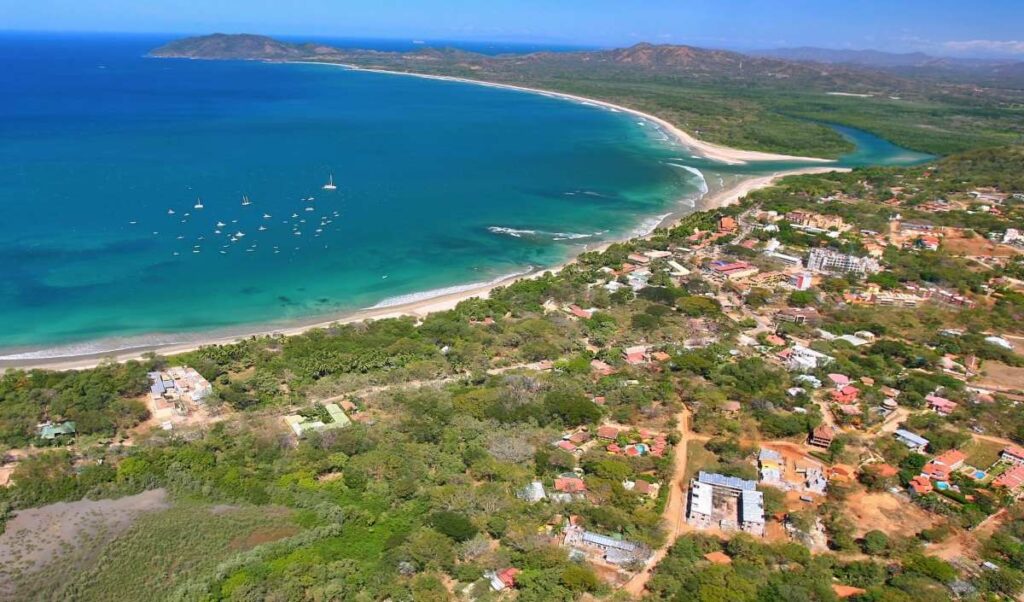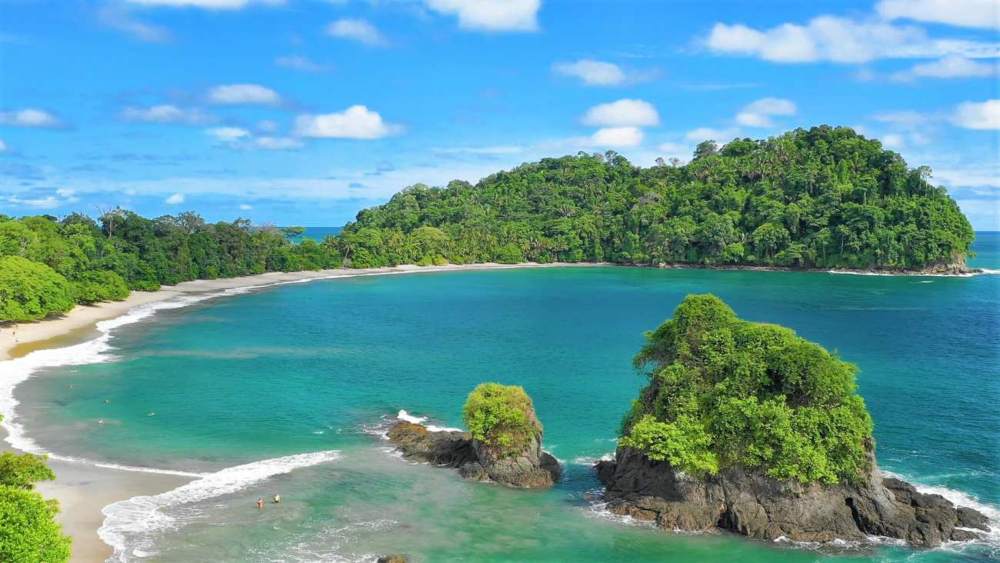Last updated on November 17th, 2023 at 05:42 am
If you’re planning a trip to Costa Rica, this article is a must-read for first-time visitors. Even if you’ve been to Costa Rica before, you should still read this guide to ensure a safe and enjoyable trip.
Traveling to other countries offers unparalleled opportunities for incredible experiences. Immersing yourself in unfamiliar surroundings is thrilling, as you encounter different cultures, try new activities, and explore breathtaking sights. However, one of the biggest concerns for travelers is safety. While the world may not be perfectly safe, it’s important to know that many destinations are perfectly safe to visit.
Costa Rica is one such destination that offers a warm and welcoming environment to tourists. Located in Central America, this small yet diverse country, Costa Rica is known as one of the most visited countries in Latin America. Renowned for its incredible natural beauty, with lush rainforests, stunning beaches, and magnificent volcanoes, it’s easy to see why.
Costa Rica is a top-rated tourist destination that offers an array of exciting experiences, from zip-lining through the jungle, surfing on the Pacific coast, and hiking to stunning waterfalls.
San José, the capital city of Costa Rica, is a great place to start your adventure. This bustling city boasts a rich cultural heritage, with museums, art galleries, and historic landmarks. While some areas in San Jose may be unsafe, most of the city is perfectly safe for tourists to explore. It’s important to exercise caution and stay in well-lit, populated areas, but with the right precautions, you can experience all that San Jose has to offer.
It’s a common misconception that other countries are not safe for tourists, but this is simply not true. With proper research and planning, you can find safe and exciting destinations to explore.
Costa Rica is one of these destinations, offering an unparalleled experience that’s sure to leave you with an unforgettable vacation experience.
Is Costa Rica Safe?
Costa Rica is a beautiful and peaceful country and is one of the safest countries to visit in all of Latin America. With a Pacific coast, a Caribbean coast, and borders with Ecuador and Nicaragua, it truly is the heart of Central America. The question is, is Costa Rica a safe country for international travel?
For the most part, the answer is yes it is safe to visit, Costa Rica is generally safe for tourists. While there are instances of violent crime, drug trafficking, money laundering, and petty crime that can occur, which is true of any country, the rates at which they happen are not high enough to be a major concern for travelers. In fact, according to the Global Peace Index and international safety standards, Costa Rica is the 38th safest country in the world and the safest in Latin America. For context, the United States sits in the 129th position.
Costa Rica is known for its many tourist attractions like their stunning beaches, lush jungles, and diverse wildlife, making it a top tourist destination. San José, the capital city, is a cultural hub that showcases the country’s rich history and art scene.
In terms of safety, Costa Rica is generally considered safe for international travel. However, it’s always important to take precautions for personal safety and be conscious of your surroundings, especially in more crowded tourist areas. The U.S. Department of State provides consular assistance to U.S. citizens in Costa Rica and recommends staying informed about local events and developments.
While Costa Rica is a relatively safe country, it’s still important to practice common sense safety measures, such as not leaving valuables unattended and avoiding walking alone at night in unfamiliar areas. So answering is Costa Rica safe, yes it is, but by taking these precautions and staying informed, travelers can enjoy all that Costa Rica has to offer with peace of mind.

Crime Rates in Costa Rica
The crime rate in Costa Rica is relatively low compared to other Latin American countries. According to the 2021 Global Peace Index, Costa Rica ranks 38th out of 163 countries and is the safest country in the world. However, like any country, it has its share of crime. The most common crimes in Costa Rica are petty theft, such as pickpocketing and purse snatching, drug trafficking, and property crimes, such as burglary and theft.
Understanding the Statistics
While the overall crime rate in Costa Rica is low, it is important to understand the specific areas where crime is more prevalent. According to the United States Department of State, the Central Pacific Coast, which includes popular tourist destinations in larger cities such as Jacó and San Jose, has a higher crime rate than other areas of the country. Visitors should be cautious and be aware of their surroundings in these areas.
Common Types of Crime in Costa Rica
Petty theft is the most common type of crime in Costa Rica. Tourists should be cautious of their belongings, especially in crowded areas such as markets and public buses. It is also important to be mindful of your surroundings and avoid carrying large amounts of cash or valuables.
Property crimes such as burglary and theft can also occur in Costa Rica. Visitors should take precautions such as locking doors and windows and not leaving valuables unattended in rental cars or on the beach.
Another common type of crime in Costa Rica is fraud. Tourists should be cautious of scams, especially involving money or property. Visitors should also be wary of unsolicited offers and requests for money or personal information.
In rare cases, violent crime can occur in Costa Rica. Visitors should exercise caution when walking alone at night, especially in areas with low lighting or little foot traffic. It is also important to be aware of the local laws and regulations, including those related to drug use and possession.
Simply put, visitors to Costa Rica can take simple steps to stay safe and enjoy their trip. By understanding the crime rates and common types of crime, travelers can take precautions and avoid becoming a victim.
Safety Tips for Visiting the Safest Country in Latin America
Even though Costa Rica is one of the safest countries in the world, there are still some risks that are inherent in traveling to a new place. You must understand the dangers you could face while in another country. Here are some tips for staying safe while visiting Costa Rica.
It is essential to note that every country has its unique risks and challenges, and Costa Rica is no exception. Before traveling to Costa Rica, it’s crucial to do some research and understand the potential risks and dangers you might face. Understanding these challenges can help you avoid them and ensure a safe and enjoyable trip. By being aware of the risks and taking precautions, you can make the most of your trip to this beautiful Central American country.
Be Aware of Local Regulations
One of the simplest mistakes that travelers make is being unaware of local laws. This location is governed by local authorities that enforce different rules than you are used to. The local governments and immigration authorities may respond differently to violations than in other places you have been. Ignorance of the laws of Costa Rica could be a recipe for disaster if you do not know how to behave. Maybe you brought some medications into the country that are classified as illegal drugs. When you enter Costa Rica, respect their ordinances and make sure you are familiar with the rules.
As with other Costa Rica travel related items, it’s important to do your research before traveling to Costa Rica to ensure that you understand the native laws and regulations. Being ignorant of the rules can lead to serious problems and jeopardize your safety. In Costa Rica, drug laws are particularly strict, and even some over-the-counter medications can be considered illegal drugs. Additionally, Costa Rica has laws regarding wildlife protection and conservation that you should be aware of.
Despite the potential risks, Costa Rica is safe for travelers who take the necessary precautions. By doing your research, understanding the local regulations, and being aware of the potential dangers, you can have a safe and enjoyable trip to this beautiful country. Remember to always exercise caution and contact your consulate office if needed.
Stay Alert for Warning Signs of Danger
Tourists tend to pay less attention to what is happening in their surroundings. Instead, they might be distracted as they photograph official buildings or get fixated on a new activity. This opens them up to potential risks that traveler protection officers may not be able to prevent completely. Be cautious by staying alert and keeping your head on a swivel. Additionally, when going on tours, make sure that you are following a trusted tour operator. Watch out for scam tours that can pop up on short notice. It is also a good idea to make sure you have cell service or know where the nearest public Costa Rica telephone is.
Use Trusted Transportation
Getting from place to place to experience tourist attractions can be stressful. It is important that you also protect yourself while doing so. As you travel from San Jose or Liberia airports, rely on trusted public transportation methods like authorized taxi stands, shuttle companies, and public buses. Popular tourist hotspots usually have many options for travel, so make sure you choose reliable public transportation like licensed taxi stands and taxi drivers. If you cannot verify official taxis, then do not take them.
Travel in Groups During the Day
Pretty much anywhere in the country is safe during the daytime, but darkness can cause a lot of problems, especially in rural areas or isolated locations. To Stay out of danger, it is best to travel with others during the daytime. This way, you can avoid the risks of armed robberies or even sexual assault. Solo female travel can be risky, especially for pregnant women, and the last thing you want to do is move through high-risk areas in San José at night. Use common sense and stick together whenever you move through Costa Rica’s urban and rural areas.
Stay on the Path
Costa Rica is one big rainforest essentially. This means it is easy to get lost in the wilderness if you do not know what you are doing. Be extra cautious in the wild by staying on the marked trails at all times. It isn’t hard to get lost in a national park that consists entirely of dense vegetation and forests, especially for solo travelers. However, its always a good idea to hire a guide when visiting a national park. Though you may be a fan of adventure tourism, be smart and don’t lose yourself in the Costa Rican wilderness, or you may find yourself in need of a medical evacuation.
The Unseen Dangers of Costa Rica's Beautiful Beaches and Rivers
Costa Rica’s beautiful beaches and rivers attract visitors from all over the world. While they offer a great opportunity for fun activities like surfing, boogie boarding, snorkeling, swimming, and white water rafting, it’s important to be aware of the unseen dangers that come with them. One thing to be cautious of are rip tides also known as rip currents. They can be hidden in plain sight and are extremely difficult to spot, making them a major cause of drowning. To ensure your safety, it’s best to visit beaches and rivers that are considered some of the safest destinations in the country. However, even in the safest places, it’s important to take extra precautions, such as always swimming with a buddy, staying within sight of a lifeguard, and paying attention to warning signs.
If you’re trying a new destination or activity, be sure to research it thoroughly before going, and for white water rafting, always go with a reputable and experienced tour company. Remember that while Costa Rica is generally safe to visit, water-related accidents can happen, so take the necessary steps to stay safe and enjoy your time in this beautiful country.
Don't Bring Valuables
Here is a simple step to be safe while in Costa Rica; leave valuables at home. Expensive items can make you a target for Costa Ricans who are willing to pickpocket or steal from tourists, especially in populated tourist areas. Additionally, don’t flash expensive items for the whole world to see. leave items such as expensive watches, diamond rings, expensive purses, or handbags at home. Whether you are in San José or a less populated town like La Fortuna or Puerto Viejo, shady individuals might take advantage of the opportunity and commit a petty crime or theft.
Health and Safety Considerations
Traveling to Costa Rica can be an exciting and adventurous experience, but it is important to prioritize health and safety while visiting. Whether you are planning on spending time in the cities or exploring the great outdoors, there are some important considerations to keep in mind. Here are some health and safety recommendations to help ensure your trip is enjoyable and worry-free.
Vaccinations and Precautions
Before traveling to Costa Rica, it is recommended that you consult with a healthcare professional to ensure you are up-to-date on all necessary vaccinations. Depending on your specific itinerary and activities, additional vaccinations may be recommended, such as hepatitis A, typhoid, and a yellow fever vaccination.
In addition to vaccinations, there are several precautions you can take to protect your health while in Costa Rica. Mosquito-borne illnesses such as dengue fever and Zika virus are a concern in some areas, particularly during the rainy season. Be sure to use insect repellent and wear protective clothing to prevent bites.
Medical Services in Costa Rica
It is always a smart decision to purchase travel insurance that includes medical coverage before embarking on any trip, including to this beautiful Central American Country. Costa Rica has a robust healthcare system, and medical care is widely available throughout the country. There are public hospitals and clinics as well as private facilities that offer a range of services. It is important to note that medical costs in Costa Rica can be high, particularly for visitors without travel insurance.
If you do require medical attention while in Costa Rica, it is recommended that you seek care at a private facility, as the quality of care may be higher than at public facilities. Some popular private hospitals in San José include CIMA Hospital and Hospital Clinica Biblica.
Staying Safe in Nature
Costa Rica is known for its stunning natural beauty, but it is important to take precautions when exploring the great outdoors. Hiking trails can be rugged and uneven, and there may be hazards such as steep drop-offs or slippery rocks. Be sure to wear appropriate footwear and bring plenty of water and snacks with you.
It is also important to be aware of potential wildlife encounters, particularly with venomous snakes and spiders. If you are not familiar with the local wildlife, it may be best to hire a guide who can help you navigate the trails safely.
Road Safety
If you plan on driving in Costa Rica, it is important to exercise caution and be aware of the rules of the road. Roads can be narrow and winding, and drivers may not always follow traffic laws. If possible, it may be best to hire a driver or use public transportation to get around.
In the event of a driving accident or emergency, you can contact the Police allocated for tourist at 911 or the Road Assistance Program at 800-977-4357.
By following these health and safety tips, you can help ensure a smooth and enjoyable trip to Costa Rica. As always, it is important to stay aware of your surroundings and take precautions to protect yourself and your belongings.
Staying Healthy: Avoiding Food and Water Contamination
Staying healthy during your travels to Costa Rica is crucial, and one way to do this is by avoiding food and water contamination. It is recommended to stay away from street food and to eat at reputable restaurants. Additionally, it’s important to remember that even though Costa Rica’s tap water is generally safe to drink, it may contain microorganisms that your body is not used to. It’s best to stick to bottled water or water that has been boiled, especially when you’re traveling to areas that may not have the safest water supply. By taking these simple precautions, you can enjoy your trip to one of the safest places in Latin America without worrying about getting sick from contaminated food or water.
Staying Safe in San José
San José, the capital city of Costa Rica, is a vibrant and bustling metropolis. While it is generally considered safe, it is still important to take precautions to ensure your safety during your visit to San Jose and any other big cities in Costa Rica.
Tips for Navigating the City
When exploring San Jose, it is important to be conscious of your surroundings. Here are some tips to help you navigate the city safely:
Use caution when using public transportation, especially at night. Consider taking a taxi or ride-sharing service instead.
Avoid carrying large amounts of cash or wearing flashy jewelry and wearing expensive watches that could attract unwanted attention. Leave valuables like these items at home and find out what currency is accepted in Costa Rica.
Remain vigilant and keep your valuables close to you and be aware of pickpockets in crowded areas.
Stick to well-lit, busy streets and avoid wandering alone in quiet or dimly-lit areas.
Be cautious of people who approach you on the street, especially if they try to engage you in conversation or ask for money.
Stay away from dark streets at night.
These items are basically common sense but you will put yourself at greater risk by ignoring them.
Safe Neighborhoods to Visit
San Jose has several neighborhoods that are considered safe for tourists to visit. Here are a few of them:
Escazu: This upscale neighborhood is home to many expats and is known for its luxury shopping, fine dining, and modern amenities.
Barrio Amón: This historic neighborhood is known for its beautiful architecture and art galleries.
San Pedro: This lively college town is home to the University of Costa Rica and has a variety of restaurants, bars, and shops.
While these neighborhoods are generally considered safe, it is still important to take precautions and use common sense when exploring any new area. Stay aware of your surroundings and trust your instincts. With a little bit of preparation and caution, you can have a safe and enjoyable visit to San Jose.
Emergency Contact Information
Traveling to a new country can be exciting, but it’s important to be prepared for unexpected emergencies such as natural disasters, auto accidents, health issues, injuries, and even small emergencies like a flat tire. In case of an emergency or need for emergency assistance in Costa Rica, it’s always good to have a contingency plan in place and have the contact information for local authorities and the consulate office readily available. Here are some important emergency contacts to keep in mind:
If You Have a Concierge, Call Them First
If you’re staying in a resort or a luxury villa in Costa Rica, chances are you have a personal concierge. This is someone who can help you with all your needs, including emergencies. A seasoned concierge will know exactly what to do and who to call for most emergencies or tough situations. They can help you navigate a difficult situation, whether it’s a medical emergency, a lost passport, or a theft.
Your concierge can help you get in touch with local authorities or emergency services, and they can also provide you with valuable information about the area, such as which neighborhoods to avoid, the best hospitals to go to, and the safest transportation options.
It’s important to establish a good relationship with your concierge when you first arrive, as they can be your lifeline in a crisis. Make sure you have their contact information handy and don’t hesitate to call them if you need help. They can also help you with non-emergency situations, such as booking tours or making restaurant reservations.
In addition to your concierge, it’s a good idea to keep a list of important emergency contacts with you at all times. This can include local police and emergency services, the nearest hospital or medical clinic, and your embassy or consulate.
Remember that in an emergency, time is of the essence, so having the right information and contacts at your fingertips can make all the difference. Take precautions and be prepared during your visit to Costa Rica.
Contacting Your Consulate Office
If you are a foreign traveler and require consular assistance in Costa Rica, you can contact your country’s embassy or consulate. They can help you with issues such as lost or stolen passports, medical emergencies, and legal assistance. Here is the contact information for some of the most common consular services in Costa Rica:
United States Embassy: +506-2519-2000 (24/7)
Canadian Embassy: +506-2242-4400 (Monday to Thursday: 7:30 a.m. to 4:00 p.m., Friday: 7:30 a.m. to 1:00 p.m.)
United Kingdom Embassy: +506-2258-2025 (Monday to Friday: 8:00 a.m. to 4:00 p.m.)
Australian Embassy: +506-2234-2181 (Monday to Friday: 9:00 a.m. to 1:00 p.m. and 2:00 p.m. to 5:00 p.m.)
Local Police and Emergency Services
If you need immediate assistance in Costa Rica, call 911 for emergency services. The local police force is known as the Fuerza Pública and can also be contacted for non-emergency situations. Here is the contact information for some important emergency services in Costa Rica:
Police: 911 or 2222-1365 (Tourist Police)
Fire: 911 or 2257-7100
Ambulance: 911 or 128
It’s worth noting that while most Costa Ricans are friendly and helpful, there are some scams and crimes that target tourists. In the unfortunate event that you fall victim to theft or fraud, report it to the police immediately. If you’re injured or need medical attention, seek out a hospital or clinic right away.
In addition to the emergency contacts above, here are some other useful numbers:
Costa Rican Red Cross: 911
Hospital CIMA San Jose: +506-2208-1000
Hospital La Catolica: +506-2246-3000
It’s also a good idea to have the address and phone number of your hotel or accommodation written down and easily accessible in case of emergency. Additionally, make sure to familiarize yourself with the local emergency services and the location of the nearest hospital or medical center.
By being prepared with the necessary emergency contact information, you can enjoy your travels in Costa Rica with peace of mind. Remember to take the necessary precautions to stay safe and healthy during your trip.
Know the Entry and Exit Requirements Prior to Arriving in Costa Rica
Knowing beforehand what the most current requirements are for entry and exiting is extremely important for anyone planning a trip to Costa Rica. It is essential to understand the country’s visa requirements and necessary documentation before arriving. Visitors must have a valid passport that will not expire for at least six months after the planned departure date. Additionally, visitors must provide proof of onward travel, such as a return ticket, to enter the country. Understanding these requirements will ensure a smooth entry and exit process and avoid any complications during the trip.
Why Visit Costa Rica?

Now that you know Costa Rica is a safe place to visit, let’s talk about why you should go there.
The Natural World
Costa Rica’s beaches are world-famous for being pristine and gorgeous. both the Pacific coast and the Caribbean coast offer incredible views of the ocean. Multiple national parks are home to abundant wildlife, sweeping rainforests, volcanos, hot springs, and diverse plant life. The Central Valley plateau is just south of San Jose and is a beautiful landscape to explore.
The Culture
From Santa Teresa to Puerto Viejo to Costa Rica’s capital, San Jose, there are plenty of opportunities to engage with the Costa Rican people. Their traditions, cuisines, and pura vida lifestyles must be experienced during your trip. Learn from local media what tourists have to try during their visit and then give it a whirl. Staying at Vista Hermosa Estate in Manuel Antonio is a great way to immerse yourself in the culture of the Costa Rican people.
The Activities
There is an endless list of exciting things to do and see in Costa Rica. Scuba diving, horseback riding, hiking, swimming, surfing, dining, and more. Make sure you buy travel insurance in case your thrill-seeking gets you injured.
Plan Your Trip Today
The Costa Rican government cares deeply about the safety of travelers to this stunning tropical country in Central America.
It doesn’t matter when you decide the best time to visit Costa Rica for you and your family, whether you are visiting during the rainy season in September or the drier months between December and April, as long as you know what to pack for your trip and stick to our safety suggestions, your trip will surely create the most cherished memories of your time in Costa Rica.



